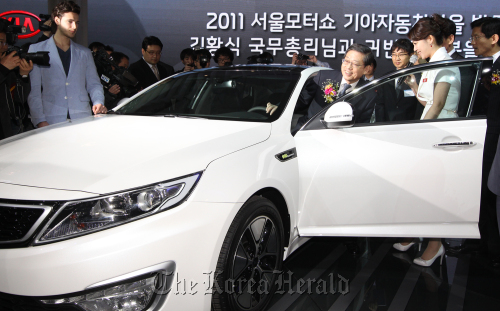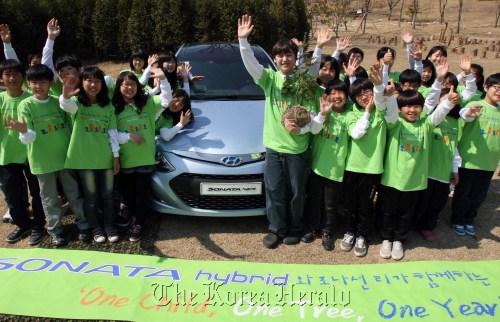At the recent Seoul Motor Show, Hyundai Motor Co. and Kia Motors Corp. each unveiled their first gasoline-electric hybrid vehicles based on their midsized sedan’s Sonata and K5.
While the carmakers had introduced hybrid electric vehicles based on the compact cars Avante and Forte powered by a combination of an electric motor and a liquefied natural gas engine, the hybrid Sonata and K5 mark their first foray into the gas-electric hybrid market that is currently dominated by Japanese carmakers.
While Korea’s two largest carmakers are joining the growing market for hybrid electric vehicles later than rivals, the hybrid Sonata and K5 come with significant improvements to existing hybrid automobiles to give them an edge in the market.
The vehicles are fitted with the newly developed 2-liter Nu engine that puts out 150 brake horsepower and a 30-kilowatt electric motor, the combination of which puts their fuel economy at 21 kilometers per liter.
According to the companies, the electric motor fitted in the two hybrid models is 18 percent smaller and 30 percent lighter than those used in hybrid electric vehicles from rival carmakers.
“While Toyota’s combined hybrid system has a complex layout and requires a relatively large motor, the hybrid electric Sonata has a simpler layout where the motor is placed between the engine and the transmission,” a Hyundai official said.
“By doing that, a smaller motor can be used, and an engine clutch is used to regulate power output from the internal combustion engine.”
In Hyundai Motor Group’s hybrid electric system, the engine clutch remains open when the vehicle is starting and when driving at low speeds enabling the vehicle to be powered without contribution from the engine.
When the vehicle is moving uphill and at higher speeds, the clutch is engaged bringing both the engine and the electric motor into play.
“When the vehicle decelerates, the regenerative braking system is engaged to recharge the battery pack ready for the next full-electric mode,” a Hyundai official said.
While the carmakers had introduced hybrid electric vehicles based on the compact cars Avante and Forte powered by a combination of an electric motor and a liquefied natural gas engine, the hybrid Sonata and K5 mark their first foray into the gas-electric hybrid market that is currently dominated by Japanese carmakers.
While Korea’s two largest carmakers are joining the growing market for hybrid electric vehicles later than rivals, the hybrid Sonata and K5 come with significant improvements to existing hybrid automobiles to give them an edge in the market.
The vehicles are fitted with the newly developed 2-liter Nu engine that puts out 150 brake horsepower and a 30-kilowatt electric motor, the combination of which puts their fuel economy at 21 kilometers per liter.
According to the companies, the electric motor fitted in the two hybrid models is 18 percent smaller and 30 percent lighter than those used in hybrid electric vehicles from rival carmakers.
“While Toyota’s combined hybrid system has a complex layout and requires a relatively large motor, the hybrid electric Sonata has a simpler layout where the motor is placed between the engine and the transmission,” a Hyundai official said.
“By doing that, a smaller motor can be used, and an engine clutch is used to regulate power output from the internal combustion engine.”
In Hyundai Motor Group’s hybrid electric system, the engine clutch remains open when the vehicle is starting and when driving at low speeds enabling the vehicle to be powered without contribution from the engine.
When the vehicle is moving uphill and at higher speeds, the clutch is engaged bringing both the engine and the electric motor into play.
“When the vehicle decelerates, the regenerative braking system is engaged to recharge the battery pack ready for the next full-electric mode,” a Hyundai official said.


The vehicles are also the world’s first hard-type electric hybrid vehicles ―- hybrid electric cars that are able to operate using only electricity at low speeds ―- to be fitted with a lithium ion polymer battery pack. In order to ensure pedestrian safety, both the K5 and the Sonata are fitted with a virtual engine sound system to enable pedestrians to hear the vehicles when in full-electric mode.
According to Hyundai Motor Group, the lithium ion polymer battery pack used in the Sonata and K5 hybrids has 63 percent higher power density and 13 percent higher energy density than nickel-hydrogen batteries used in other hybrid cars available on the market.
Power density refers to the efficiency of power transfer, while energy density indicates the amount of energy that can be stored within a given volume of battery.
In addition, the lithium ion polymer battery pack is 25 percent lighter than conventional batteries used in hybrid electric vehicles, allowing higher fuel efficiency, the company said.
In addition to using lithium polymer battery packs, Hyundai and Kia have given their first gasoline-electric hybrid cars a number of features to gain an edge over the competition.
The Hyundai Sonata and Kia K5 hybrid vehicles are fitted with six-speed automatic transmission developed specifically for hybrid electric vehicles.
“Unlike hybrid electric vehicles from competitors that are commonly fitted with continuous transmission, the specially designed six-speed automatic transmission allows the vehicle to respond more dynamically,” a Hyundai official said.
“In addition, we were able to provide a smoother driving experience by using the electric motor to absorb gearshift shock.”
The hybrid electric versions of the two sedans have also been given design changes to differentiate them from their internal combustion engine-driven cousins.
“In the Sonata hybrid, Hyundai’s design identity of ‘fluidic sculpture’ has been maintained, but the vehicle was given a hexagonal radiator grill to give the car a modern but eco-friendly image,” a Hyundai official said.
“The headlamps have been given white LED position lamps to highlight the eco-friendly image, while the rear lamps have been designed for a more three dimensional feel.”
The Hyundai official added that the Sonata hybrid is also fitted with aerodynamically designed parts, while the upholstery is produced using naturally occurring anti-bacterial materials.
Such features are also found in the hybrid electric K5.
Along with such features, Hyundai and Kia have given their first gasoline-electric hybrid cars the latest interior features including a 4.2-inch color TFT-LCD supervision cluster.
By Choi He-suk (cheesuk@heraldcorp.com)











![[Today’s K-pop] BTS pop-up event to come to Seoul](http://res.heraldm.com/phpwas/restmb_idxmake.php?idx=644&simg=/content/image/2024/04/17/20240417050734_0.jpg&u=)




![[KH Explains] Hyundai's full hybrid edge to pay off amid slow transition to pure EVs](http://res.heraldm.com/phpwas/restmb_idxmake.php?idx=652&simg=/content/image/2024/04/18/20240418050645_0.jpg&u=20240419100350)

